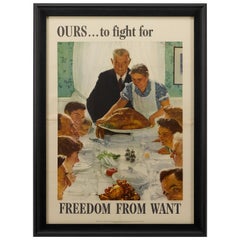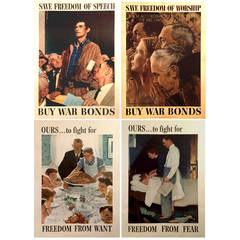Norman Rockwell 4 Freedom Posters
Recent Sales
Vintage 1940s American Historical Memorabilia
Vintage 1940s American Posters
Norman Rockwell for sale on 1stDibs
Norman Rockwell is among the most revered painters of the 20th century. His figurative and portrait paintings reflect an innocent and idyllic America described by the artist as "life as I would like it to be." For nearly 50 years, he illustrated the covers of The Saturday Evening Post in a rich and emotive style that gave distinctive personalities to his imagined characters. In total, Norman Rockwell created more than 4,000 works of art over the course of his life.
Rockwell was born in 1894 in New York City. His artistic aspirations took shape early on, and when he was 14 years old, he took classes at the New York School of the Art, which is now the Parsons School of Design. Later, he attended the Art Students League of New York, where he studied under influential painters Thomas Fogarty and George Bridgman. While still a teen, Rockwell became art director of the Boy Scouts of America publication Boys' Life.
At 21, Rockwell moved to New Rochelle, New York, and opened a studio with fellow illustrator Victor Clyde Forsythe. He created illustrations for magazines like Literary Digest and Life before his first cover for The Saturday Evening Post was published when he was 22. In 1939, after moving to Arlington, Vermont, Rockwell pivoted to making the nostalgic paintings of small-town and iconic America for which he is best known — scenes of Christmas dinner, children playing in the street and national treasures like Ruby Bridges and Rosie the Riveter.
In 1943, a speech previously given by President Franklin Roosevelt inspired Rockwell to create his most famous series, “The Four Freedoms,” which was exhibited all over the United States. The series included four pieces entitled Freedom of Speech, Freedom to Worship, Freedom from Want and Freedom from Fear.
Rockwell moved with his family to Stockbridge, Massachusetts, in 1953, where he spent the rest of his life. My Adventures as an Illustrator — the autobiography Rockwell wrote with the help of his son, Thomas — was published in 1960. In 1963, Rockwell ceased working with The Saturday Evening Post and started drawing illustrations for Look magazine.
The world’s largest collection of original Rockwell art can be found at the Norman Rockwell Museum in Stockbridge. The artist was awarded the Presidential Medal of Freedom in 1977, and he passed away peacefully in his home the following year.
On 1stDibs, find a collection of original Norman Rockwell paintings, prints, drawings and other works.
Finding the Right posters for You
Add a welcome personal touch to your space and tie your distinctive interior scheme together by introducing antique and vintage posters to any and every room of your home.
In the late 19th century, following the advent of text-heavy posters printed from woodblocks for use in taverns and shop windows, hand-drawn poster art had become commonplace in regions such as France, England and the United States. Well-known illustrators were commissioned to produce decorative posters to advertise political campaigns, theatrical events, books, household goods and other items. Early poster artists used a printmaking technique called lithography, which sees drawings or paintings created on a stone (or metal) surface with an oil-based substance, such as a greasy crayon or tusche (an oily wash). The image is eventually affixed to the surface by means of a chemical reaction, and ink adheres to certain sections of the surface while non–image areas are made to repel the ink.
If you wanted a color lithograph in the early days, the number of stones prepared had to match the number of colors you commissioned for the poster. French painter Jules Chéret, widely known as the father of the modern poster, designed some of history's most popular lithographic posters that featured color. Today, Chéret’s art is highly collectible, along with original works by Czech painter and decorative artist Alphonse Mucha, whose posters advertising theatrical productions helped define Art Nouveau.
Over time, poster artists transitioned to more advanced techniques. Using silkscreens, woodblocks and photolithography, painters and illustrators printed larger quantities at a faster rate.
If you’ve finally tracked down that vintage movie poster, mid-century modern promotional travel poster or other work and you’re looking to find out if it is valuable, distinguishing between an original poster and a reproduction can be complicated. A professional appraiser can work with you on factors such as rarity, assessing the physical condition of your poster and authenticating your piece. For now, take care of your new acquisition because conserving posters is essential in helping them retain their value. A practical conservation method is to have the work mounted on archival, acid-free paper and thin artist’s canvas, then enclosing it in a sturdy frame. (And here is a primer on how to hang wall art, be it arranged gallery-style or otherwise.)
On 1stDibs, find all kinds of posters for your home today.

